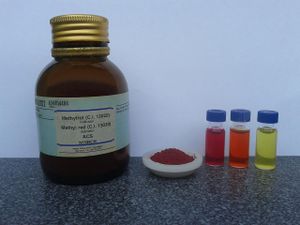Difference between revisions of "Methyl red"
| (2 intermediate revisions by the same user not shown) | |||
| Line 106: | Line 106: | ||
| OtherFunction = | | OtherFunction = | ||
| OtherFunction_label = | | OtherFunction_label = | ||
| − | | OtherCompounds = [[Methyl orange]] | + | | OtherCompounds = [[Methyl orange]]<br>[[Methyl yellow]] |
}} | }} | ||
}} | }} | ||
| − | '''Methyl red''' is an azo dye indicator used for determining the pH of a solution. It has the chemical formula '''C<sub>15</sub>H<sub>15</sub>N<sub>3</sub>O<sub>2</sub>'''. | + | '''Methyl red''' is an azo dye indicator used for determining the [[pH]] of a solution. It has the chemical formula '''C<sub>15</sub>H<sub>15</sub>N<sub>3</sub>O<sub>2</sub>'''. |
==Properties== | ==Properties== | ||
| Line 132: | Line 132: | ||
==Handling== | ==Handling== | ||
===Safety=== | ===Safety=== | ||
| − | Like most dyes, methyl red will stain most objects and due to its insolubility in water it's very difficult to wash. | + | Like most dyes, methyl red will stain most objects and due to its insolubility in water, it's very difficult to wash off. |
Methyl red is classed by the IARC in group 3, and not considered to cause cancer in humans. | Methyl red is classed by the IARC in group 3, and not considered to cause cancer in humans. | ||
Latest revision as of 21:47, 28 December 2023
 Methyl red in solid form and as solution at pH < 4.4 (red), pH 4.4-6.2 (orange) and pH > 6.2 (yellow)
| |
| Names | |
|---|---|
| IUPAC name
2-(N,N-dimethyl-4-aminophenyl) azobenzenecarboxylic acid
| |
| Preferred IUPAC name
2-{[4-(Dimethylamino)phenyl]diazenyl}benzoic acid | |
| Other names
C.I. 13020
C.I. Acid Red 2 | |
| Properties | |
| C15H15N3O2 | |
| Molar mass | 269.30 g/·mol |
| Appearance | Deep red solid |
| Odor | Odorless (fresh) Faint fish-like (old) |
| Density | 1.31 g/cm3 |
| Melting point | 179–182 °C (354–360 °F; 452–455 K) (decomposes) |
| Boiling point | Decomposes |
| Almost insolule | |
| Solubility | Soluble in glacial acetic acid, benzene, chloroform, ethanol, formic acid, lipids Slight soluble in acetone Almost insoluble in petroleum ether, toluene |
| Vapor pressure | ~0 mmHg |
| Hazards | |
| Safety data sheet | FisherSci |
| Related compounds | |
| Related compounds
|
Methyl orange Methyl yellow |
| Except where otherwise noted, data are given for materials in their standard state (at 25 °C [77 °F], 100 kPa). | |
| Infobox references | |
Methyl red is an azo dye indicator used for determining the pH of a solution. It has the chemical formula C15H15N3O2.
Contents
Properties
Chemical
Methyl red turns red in pH below 4.4, orange between 4.4 and 6.2 (more clear at 5.1) and yellow in pH over 6.2.
Physical
Methyl red is a deep red solid, almost insoluble in water, but more soluble in organic solvents, such as glacial acetic acid, hot acetone, benzene, chloroform, ethanol, formic acid, as well as lipids. While odorless, old samples have a faint fish-like smell. Although in some literature its density is given the value of 0.791 g/cm3, in reality the value 1.31 g/cm3 is the correct one, as methyl red sinks when added to water.[1]
Availability
Methyl red can be purchased from chemical suppliers, in both powdered and solution form. Can also be found online.
Preparation
Methyl red can be prepared by diazotization of anthranilic acid with hydrochloric acid and sodium nitrite, followed by reaction with dimethylaniline.
Projects
- pH indicator
- Make universal indicator
- Methyl red test
- Make anthranilic acid
Handling
Safety
Like most dyes, methyl red will stain most objects and due to its insolubility in water, it's very difficult to wash off.
Methyl red is classed by the IARC in group 3, and not considered to cause cancer in humans.
Storage
Methyl red should be stored in closed amber bottles, away from light and acids.
Disposal
Methyl red can be neutralized with a strong oxidizing solution, such as piranha solution, chromic acid or Fenton's reagent, followed by neutralization and then poured down the drain after all the methyl red has been neutralized. Since most of methyl red neutralized this way is either as solution or traces, there is little risk or splashing.
References
- ↑ Neuhaus; Zeitschrift fuer Kristallographie, Kristallgeometrie, Kristallphysik, Kristallchemie; vol. 103; (1941); p. 297,303